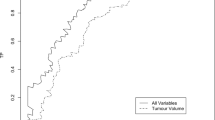Abstract
The clinical utility of the percent of positive prostate biopsies in predicting prostate-specific antigen (PSA) outcome following radical prostatectomy (RP), or external beam radiation therapy (RT), for men with PSA detected, or clinically palpable prostate cancer was investigated.
After accounting for the established prognostic significance of the PSA level, biopsy Gleason score and the clinical T-stage, the percent of positive prostate biopsies added clinically significant information regarding time to PSA failure following RP. These findings were validated in the intermediate risk patients using an independent surgical and radiation data set.
This is a preview of subscription content, access via your institution
Access options
Subscribe to this journal
Receive 4 print issues and online access
$259.00 per year
only $64.75 per issue
Buy this article
- Purchase on Springer Link
- Instant access to full article PDF
Prices may be subject to local taxes which are calculated during checkout
Similar content being viewed by others
Author information
Authors and Affiliations
Corresponding author
Rights and permissions
About this article
Cite this article
D'Amico, A., Whittington, R., Malkowicz, S. et al. Investigating the clinical utility of the percent of positive prostate biopsies in predicting PSA outcome following local therapy for patients with clinically localized prostate cancer. Prostate Cancer Prostatic Dis 3, 259–264 (2000). https://doi.org/10.1038/sj.pcan.4500413
Received:
Accepted:
Published:
Issue Date:
DOI: https://doi.org/10.1038/sj.pcan.4500413
Keywords
This article is cited by
-
Benchmarks for success in focal therapy of prostate cancer: cure or control?
World Journal of Urology (2010)



